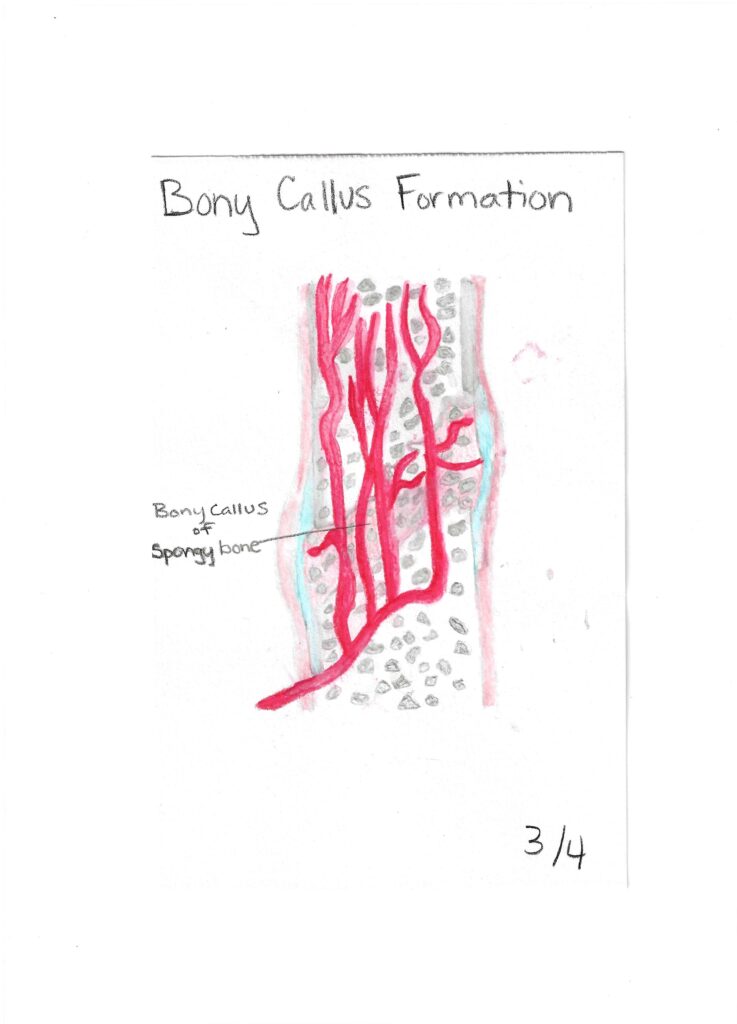Bone, also called osseous tissue, is a type of hard, dense connective tissue that forms most of the adult skeleton, which functions as the support structure of the body (Open Stax, 2022). Bone fractures describe linear deformations or discontinuities (breakage) of bones due to a force that exceeds the modulus of elasticity (ability to bend) of a bone and can be emotionally devastating and physically traumatic. Unfortunately, I would know. On October 9, 2018, while fighting wildland fire in Oregon, I sustained a fracture of my right leg while twisting my upper body to move tree debris from the fire line, resulting in pain, swelling, and loss of function. While painful, it was the healing and rehabilitation process that would prove to be the most challenging, both mentally and physically. By the time I reached a medically stable status in 2023, I had undergone four surgeries and three bouts of physical rehabilitation to rebuild my strength, balance, and bone density. Here, I touch on fractures and review in more detail the chronological order of the major steps of fracture repair.
Fractures are the most common large-organ injury sustained by humans (Einhorn & Gerstenfeld, 2015). Eight major fracture types include transverse, oblique, spiral, comminuted, impacted, greenstick, compound, and simple fractures (Open Stax, 2022). Also called a Maisonneuve fracture, a spiral fracture of the proximal fibula is most often seen due to twisting of the long bones in the body, including the femur, fibula, and tibia (Hensel & Harpstrite, 2002). The healing and repairing process of a spiral or Maisonneuve fracture is typically a lengthy and intensive multi-step biological process where specific regenerative patterns change the expression of several thousand different genes (Marsell & Einhorn, 2011).
Through surgery, physical therapy, and medicine for pain and inflammation, the aim is to restore function and damage of the bone to its pre-injury state and pre-injury cellular composition (ElHawary et al., 2021). The four basic major steps in fracture repair follow a series of chronological steps which I illustrated in four chronologically ordered watercolor depictions fracture repair. First, a fracture hematoma forms (Figure 1). Then, internal and external calli form (Figure 2). Next, cartilage of the calli is replaced by trabecular (porous bone composed of trabeculated tissue) bone (Figure 3). Finally, remodeling occurs where old or damaged bone is resorbed, followed by the deposition of new bone material, completing the healing process (ElHawary et al., 2021) (Open Stax, 2022) (Figure 4).
Immediately upon fracture to osseous tissue in the body, blood begins to clot. After six to eight hours, the blood clot forms a fracture hematoma as part of the body’s acute inflammatory response, where the disruption of blood flow to the bone soon results in the death of bone cells around the fracture (Einhorn & Gerstenfeld, 2015). After approximately two days, chondrocytes (cells which have secreted the matrix of cartilage and become embedded in it) from the endosteum (layer of connective tissue that line the inner surfaces of bones) combine to create a structure called the internal callus through secretion of a fibrocartilaginous matrix between the two ends of the broken bone, while the periosteal chondrocytes and osteoblasts (bone building cells) create an external callus consisting of hyaline cartilage and bone on the outside of the break (Open Stax, 2022). This step provides stability to the fracture.
Over the next couple months, osteoclasts (cells which break down osseous tissue) resorb the dead bone (Einhorn & Gerstenfeld, 2015). Next, osteogenic (bone-producing) cells activate, multiply, and differentiate into osteoblasts. The cartilage in the calli is replaced by trabecular bone by endochondral (within cartilage) ossification (Open Stax, 2022). In the final stage of repair, the internal and external calli come together, and dense, compact bone replaces spongy bone on the outside of the fracture, completing the fibular fracture process (Einhorn & Gerstenfeld, 2015). Although minor swelling may stay behind on surface of the bone, that region of injury undergoes remodeling, and eventually no external signs of the trauma remain (ElHawary et al., 2021).




Referenced Works
Einhorn, T. A., & Gerstenfeld, L. C. (2015). Fracture healing: Mechanisms and interventions. Nature Reviews Rheumatology, 11(1), 45–54. https://doi.org/10.1038/nrrheum.2014.164
ElHawary, H., Baradaran, A., Abi-Rafeh, J., Vorstenbosch, J., Xu, L., & Efanov, J. I. (2021). Bone healing and inflammation: Principles of fracture and repair. Seminars in Plastic Surgery, 35(3), 198. https://doi.org/10.1055/s-0041-1732334
Hensel, K. S., & Harpstrite, J. K. (2002). Maisonneuve fracture associated with a bimalleolar ankle fracture–dislocation: A case report: Journal of Orthopaedic Trauma, 16(7), 525–528. https://doi.org/10.1097/00005131-200208000-00014.
Marsell R, Einhorn TA. The biology of fracture healing. Injury. 2011 Jun;42(6):551-5. DOI: 10.1016/j.injury.2011.03.031. Epub 2011 Apr 13. PMID: 21489527; PMCID: PMC3105171.
OpenStax. (2022). Anatomy and Physiology (2nd ed.). OpenStax. https://openstax.org/details/books/anatomy-and-physiology-2e

Bone fractures are linear deformations and discontinuities of bones due to force greater than the bone’s modulus of elasticity. These bone fractures are the most common large organ injuries humans experience, with eight major fracture types, including both short and long healing times, that can be categorized into a four-step process. The eight different types of fractures can be identified as transverse, oblique, spiral, comminuted, impacted, greenstick, compound, and simple fractures. Depending on the fracture type, recovery can include physical therapy, medications, and even surgery to heal the damaged bone. First, a fractured hematoma is formed, followed by internal and external calli forms. After, the cartilage of the calli is then replaced with porous bone, referred to as trabecular bone. Lastly, remodeling of the bone happens. This is when the old or damaged bone is re-absorbed through an osteoclastic process, and new bone is created through an osteoblastic process, leading to healing. Once the bone has been remodeled, there should be no external signs of the previous trauma it has endured.